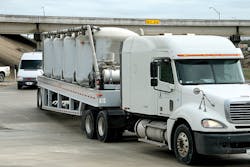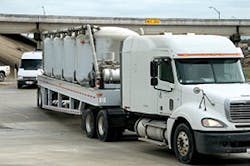Transportation, logistics companies gain from US shale
As the shale energy revolution is gaining speed in the United States, transportation and logistics companies are experiencing an immediate and dramatic impact, according to a new PricewaterhouseCoopers LLP (PwC) report, Shale Energy: A potential game changer—Implications for the US transportation & logistics industry.
Since 2010, the United States has emerged as the largest natural gas producer in the world and the Energy Information Administration forecasts that by 2040, 50% of the country’s natural gas supply will come from shale gas, dramatically impacting several segments of the transportation and logistics industry.
According to PwC’s report, the shale oil boom is creating considerable opportunities for the railroad, trucking, marine shipping, and airline industries as transport is needed to move gas, oil, and waste by-products.
Trucking—The low price of liquefied natural gas (LNG) relative to the more expensive diesel fuel has led many companies to switch to vehicles that run on natural gas. However, in order for trucking companies to expand their use of more affordable fuels, there needs to be infrastructure support. As part of America’s Natural Gas Highway initiative, a network of approximately 150 LNG truck fueling stations on interstate highways are scheduled to be in operation by the end of 2013. In addition to changing fuel dynamics, trucking activity has increased as a result of shale production as trucks haul fresh water, frack sand, waste products, and heavy equipment.
Railroads—In addition to transporting people, equipment, and oil, railroads are being used to haul the chemicals needed in the shale extraction process and to carry away waste products. The railroad industry is getting a boost from the positive effects of shale on the US chemical industry as well, since rail is essential to the movement of chemicals, with nearly a quarter of US chemical shipments being transported by rail.
“The inbound and outbound use of rail has led to a surge in demand for cars that can carry crude oil, and rail car companies are reaping the benefits, experiencing a backlog of orders for petroleum carrying cars and reporting strong financial results,” continued Kletzel. “In some shale-producing regions, the railroads have experienced such an uptick that they have had to build additional infrastructure to keep up with the increasing demand. Rail is quickly becoming a favored mode of transport because it is cheaper than trucking and more flexible than pipelines.”
Marine Shipping—The North American shipping industry could become a major exporter of natural gas, driven by shale gas drilling activity. There are more than 20 proposed LNG export terminals seeking permits to allow total processing of about 30 billion cubic feet a day, according to the US Department of Energy. If currently pending applications are approved, US exports could result in approximately 3,600 new LNG tanker departures per year. The shipping industry also is expected to play an increasing role in the transportation of machinery and other products needed for exploration and production.
Airlines—The high price of jet fuel, the single largest cost component for airlines, coupled with the volatility of crude oil prices, is spurring a search for cheaper alternatives, such as those based on natural gas, states PwC’s report. The use of natural gas for jet fuel is still years away from widespread commercial use, but the incentive is there for development, given today’s concerns around carbon dioxide emissions. In the near-term, however, airports and airlines benefit from the increased traffic to and from the major shale gas regions. PwC’s analysis shows that flights originating in North Dakota airports serving the Bakken shale field have experienced an increase in load factors of almost 10% over the last five years as traffic has nearly doubled.
“While pipelines may eventually move the bulk of shale oil and gas, it will take time to develop the infrastructure, and rail, trucks, and planes will still be needed to transport people and equipment while ships will carry LNG to other parts of the world,” Kletzel said. “As shale energy helps to revive US manufacturing, it will impact most transportation modes, as they are needed to move products both domestically and abroad. Transportation and logistics executives should consider the opportunities currently presented by the rapid growth of shale energy, as the ‘winners’ will start developing strategic plans that consider the impact of shale on the overall economy and the potential it presents for the growth of their business now and for the foreseeable future.”
For a copy of PwC’s Shale energy: A potential game-changer - Implications for the US transportation & logistics industry, please visit: www.pwc.com/us/industrialproducts. ♦

